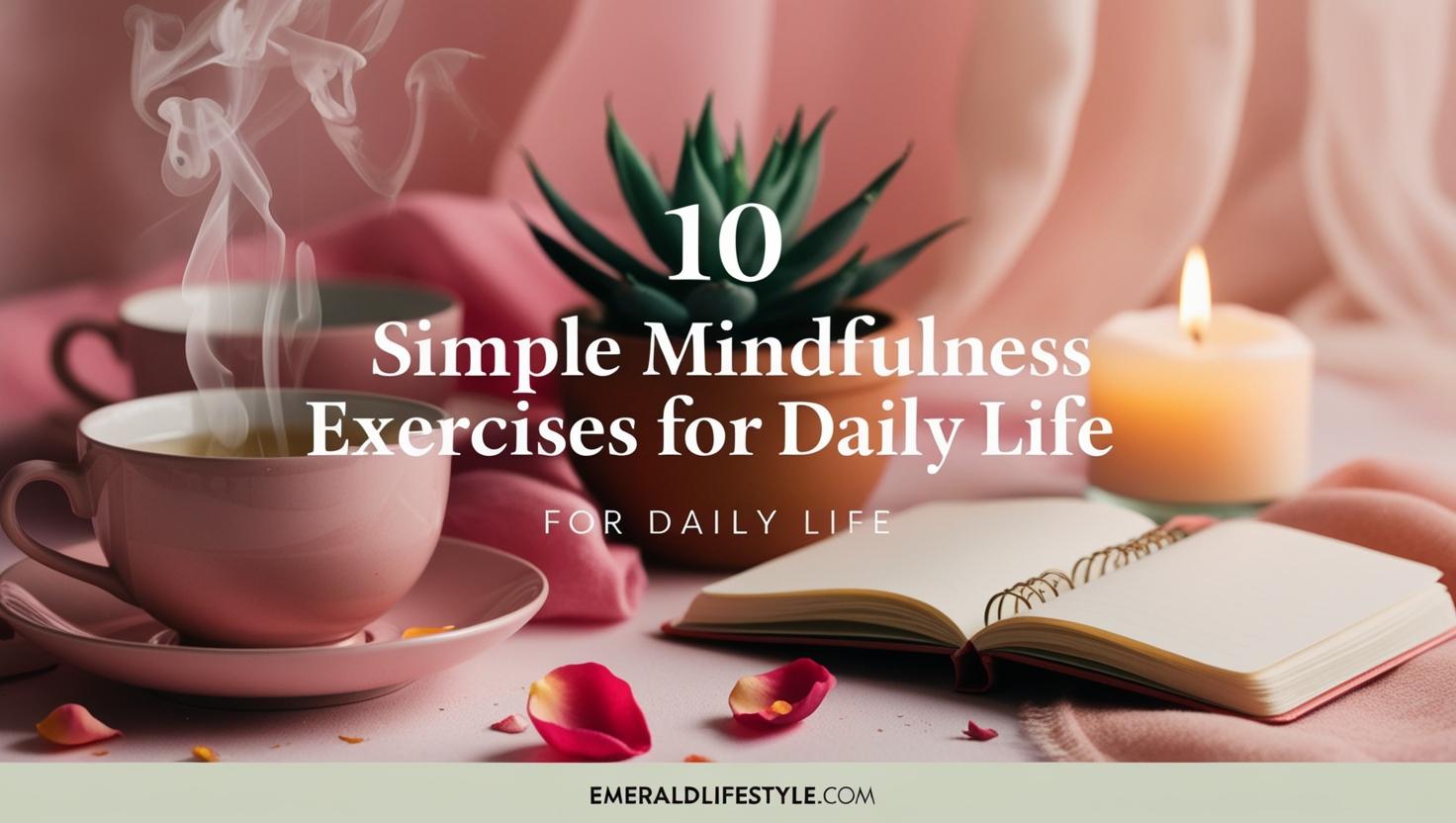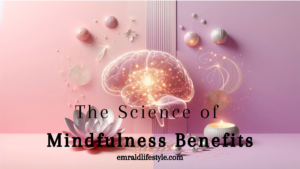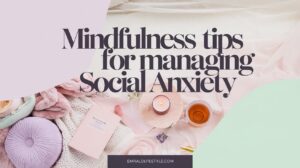In today’s fast world, it’s easy to get lost in deadlines and digital distractions. But, finding stillness can change your day. Mindfulness exercises is a powerful tool that can reduce stress, improve focus, and bring peace.
I’ve seen mindfulness change lives, and I’m excited to share ten simple exercises with you. These can be added to your daily routine, no matter your experience level. They help you stay present and find joy in the chaos.

Let’s explore how mindfulness can make your life better. You’ll learn to find calm, become more aware, and reach your full potential. Start with one moment of mindfulness today.
Understanding Mindfulness and Its Benefits for Daily Living
Mindfulness research has shown its deep impact on our well-being. It helps us stay present and aware. This leads to many benefits that make our daily lives better.
The Science Behind Mindfulness Practice
Studies have found that mindfulness changes our brain. It improves our focus, emotional control, and stress handling. It also makes our brain’s learning and emotional areas stronger.
Physical and Mental Health Benefits
- Improved immune function and reduced inflammation
- Enhanced sleep quality and duration
- Decreased symptoms of depression and anxiety
- Increased resilience and ability to cope with life’s challenges
How Mindfulness Reduces Stress and Anxiety
Mindfulness helps us notice our thoughts and feelings without judgment. This awareness lets us handle stress better. We learn to accept the moment and manage our worries.
“Mindfulness is not about getting rid of thoughts or emotions; it’s about creating a different relationship to them.”
By practicing mindfulness, we gain many benefits. These improve our mental and physical health. They help us deal with life’s challenges more easily.
Mindful Breathing: The Foundation of Present Moment Awareness
At the heart of mindfulness is breath awareness. Focusing on our breath opens the door to the present moment. It brings us deep relaxation and sharp focus. Techniques like diaphragmatic breathing are great for starting your mindfulness journey.
Mindful breathing helps us relax by reducing stress hormones. It calms our body and mind. Just a few minutes of breath awareness can bring us peace and balance.
- Find a comfy seat, either on a chair or the floor. Close your eyes or keep a soft gaze.
- Notice how your breath moves in and out through your nose or how your belly rises and falls.
- Let your breathing be natural, without trying to control it.
- If your mind drifts, gently return to your breath. Don’t judge yourself for getting distracted.
- Keep practicing for 5-10 minutes, or as long as feels right.
Make mindful breathing a part of your day. It boosts your awareness of the present moment. This can lead to many health benefits.
| Breathing Technique | Description | Benefits |
|---|---|---|
| Diaphragmatic Breathing | This method, also called “belly breathing,” involves deep nose breathing. Your belly expands when you inhale and contracts when you exhale. | It relaxes you, lowers stress and anxiety, improves breathing, and can be done anywhere. |
| 4-7-8 Breathing | Inhale for 4 seconds, hold for 7, then exhale for 8. | It calms your mind, reduces anxiety, and helps you sleep better. |
| Alternate Nostril Breathing | This technique involves closing one nostril and breathing in through the other. Switch sides when you exhale. | It balances your brain, lowers stress, and boosts focus and concentration. |
Using these breathing techniques daily can enhance your breath awareness, relaxation, and focused attention. It unlocks the power of the present moment.
Breathing exercises are proven to help reduce stress and improve mental focus, supported by research from the National Institutes of Health.
Mindfulness Exercises for Morning Routines
Start your day with mindfulness. Try these simple morning meditation and intention-setting practices. Adding morning meditation, mindful rituals, and intention setting to your routine can make your day better. It helps you feel positive and enjoy the benefits of mindfulness.
Wake-Up Meditation Techniques
Start with a few minutes of morning meditation. Sit comfortably, close your eyes, and focus on your breath. Notice how you breathe in and out. You can also do a body scan, focusing on each part of your body.
Mindful Morning Coffee or Tea Ritual
Enjoy your morning drink with full attention. As you drink your mindful coffee or tea, notice the smell, feel, and taste. Feel the sensations in your body and any thoughts that come up. This simple ritual can make you feel calm and grounded.
Starting Your Day with Intention Setting
Take a few minutes to set your intention for the day. Think about what you want to do or feel. This intention setting helps you stay focused and motivated. It makes sure you have a positive start to the day.
“The key is to be in a state of permanent connectedness with your inner self, in order to be able to know yourself better. Meditation is a way to access that dimension.” – Deepak Chopra
Body Scan Practice for Enhanced Self-Awareness
Practicing a body scan is a powerful mindfulness technique. It helps you cultivate body awareness and release physical tension. This simple exercise encourages you to tune in to the sensations in your body. It promotes progressive relaxation and mindful self-observation.
To start a body scan, find a comfortable seated or lying position. Close your eyes and take a few deep breaths. This allows your body to settle. Then, gently shift your attention to the sensations in your feet, noticing any feelings of heaviness, lightness, or tingling.
Slowly scan your awareness up through your legs, hips, and abdomen. Observe each area with curiosity and non-judgment. Continue the scan, moving your focus to your back, chest, and shoulders. Note any areas of tension release or body awareness.
- Bring your attention to your hands, arms, and neck. Observe the unique sensations in each region.
- Lastly, scan your face, scalp, and the top of your head. Allow your entire body to relax and let go.
The body scan practice can be done for as little as 5-10 minutes. Or you can extend it to 20-30 minutes for a more immersive experience. With regular practice, you’ll develop a greater sense of self-awareness. You’ll also be able to quickly recognize and release physical and mental tension.
| Benefits of Body Scan Practice | What You’ll Experience |
|---|---|
| Reduced stress and anxiety | Increased body awareness and relaxation |
| Improved sleep quality | Greater sense of calm and inner peace |
| Enhanced focus and concentration | Deeper connection with your physical and emotional well-being |
Incorporating a daily body scan practice into your routine can be transformative. It can lead to a more mindful, self-aware, and balanced lifestyle.
According to the American Psychological Association, mindfulness has been shown to reduce anxiety, enhance focus, and improve emotional well-being.
“The body is the temple of the soul. When you understand the body, you understand the mind, and when you understand the mind, you understand the soul.”
Incorporating Mindful Walking Into Your Daily Schedule
Mindful walking is a way to connect with the present moment. It helps you feel more aware of your body and the world around you. By walking in sync with your breath, you can refresh your mind and body.
Indoor Walking Meditation Tips
You can still practice walking meditation indoors. Find a quiet, clean space to walk slowly. Keep your eyes soft and focus on your body’s feelings.
Nature-Based Walking Practices
Walking outside can make mindful walking even more powerful. Notice the sights, sounds, and smells as you walk. Walking in nature can bring you peace and inspiration.
Combining Movement with Breath Awareness
Focus on your breath while walking. Let your steps match your breathing. This practice can make you feel more present and calm, wherever you walk.
Mindful Eating Practices for Better Nutrition
In today’s fast world, we often eat quickly without enjoying our food. But, by using conscious eating methods, we can better enjoy our meals. This leads to healthier eating and more nutritional benefits.
At the heart of mindful eating is sensory awareness. When you eat, notice the colors, textures, and smells of your food. Use all your senses to enjoy the meal fully.
- Take your time with each bite, chewing well and tasting the flavors.
- Listen to your body’s hunger and fullness signals.
- Thank the food for its nourishment, thinking about its journey to you.
This conscious eating way helps you have a better mindful relationship with food. It leads to smarter food choices and better health.

Adding mindful eating to your life can greatly improve your health. Enjoy each meal slowly, letting your senses guide you to a more satisfying and healthy dining experience.
Five-Minute Mindfulness Exercises for Busy People
In today’s fast world, finding time for *micro-meditation* and *workplace mindfulness* can be tough. But, short mindfulness practices can change how we handle *stress relief at work* and find quick calm. Here are some easy mindfulness exercises for busy folks to add to their day.
Quick Desktop Meditation Techniques
When work gets too much, a short pause can help a lot. Try a 5-minute *micro-meditation* at your desk. Sit up, close your eyes, and focus on your breath. If your mind drifts, gently bring it back to your breath.
Mindful Breaks During Work
Use your breaks wisely instead of scrolling through social media. Try *workplace mindfulness* by taking a short walk. Notice your body and the world around you. Or, try progressive muscle relaxation to release tension.
Short Breathing Exercises
- Box Breathing: Inhale for 4 counts, hold for 4 counts, exhale for 4 counts, hold for 4 counts. Repeat as needed.
- 4-7-8 Breathing: Inhale for 4 counts, hold for 7 counts, exhale for 8 counts. This calming technique can help reduce *stress relief at work*.
- Alternate Nostril Breathing: Use your thumb and index finger to gently close off one nostril at a time as you inhale and exhale, alternating sides.
Make these *quick relaxation techniques* a daily habit. Begin with just a few minutes a day. Soon, you’ll see how *micro-meditation* and *workplace mindfulness* improve your well-being.
Evening Wind-Down Mindfulness Practices
As the day ends, it’s key to have a calming bedtime relaxation routine. This helps your mind and body relax. Adding mindfulness exercises to your nighttime routine can ease stress and boost sleep improvement.
Try body scan meditation to unwind. Sit or lie down comfortably. Breathe deeply, then focus on each body part, noticing any tension. Release each muscle, letting go of stress.
- Imagine a wave of calm moving through you, from head to toe.
- Focus on your breathing, letting it slow and deepen.
- If your mind drifts, gently return to the present.
Gratitude journaling is also helpful. Before bed, think about the day and write down three to five things you’re thankful for. This practice can make you feel more positive and ready for sleep.
“Bedtime is a great time to relax and release the day’s worries. Adding mindfulness exercises to your nighttime routine can help improve sleep and well-being.”
By using these evening wind-down mindfulness practices, you can make your bedtime calming and restorative. This prepares you for a good night’s sleep and a fresh start the next day.

Conclusion
Remember, adding mindfulness exercises to your daily life is key. These practices can change your life in big ways. They offer immediate benefits, but their real power is in changing how you live.
Starting a daily practice is crucial for seeing the long-term benefits of mindfulness. By regularly stopping to be present and aware, you grow more centered and joyful. This journey of self-discovery can lead to big lifestyle changes and a more mindful life.
There’s no single way to practice mindfulness. Try different exercises to find what works best for you. Celebrate your small wins and be patient with yourself. With dedication and an open mind, mindfulness can greatly improve your life, making it more present, meaningful, and fulfilling.
FAQ
Q: What is the purpose of this article?
A: This article introduces ten mindfulness exercises. They help improve well-being, reduce stress, and boost focus. These practices are great for both beginners and those with more experience.
Q: What are the key topics covered in this article?
A: The article talks about the science of mindfulness and its health benefits. It also discusses how mindfulness helps with stress and anxiety. You’ll learn about mindful breathing, morning routines, body scans, and more.
Q: How can mindfulness benefit daily life?
A: Mindfulness can make daily life better. It reduces stress and anxiety, improves health, and boosts focus. It also helps with emotions and makes life more fulfilling.
Q: What are some of the key mindfulness techniques covered in this article?
A: The article shares various mindfulness techniques. These include mindful breathing, body scans, walking, eating, quick desktop meditations, and evening wind-down practices.
Q: How can readers incorporate mindfulness into their daily routines?
A: The article offers tips on adding mindfulness to daily life. This includes morning routines, work breaks, meals, and evening rituals. Try different techniques to find what works best for you.
Q: What are the benefits of practicing mindful breathing?
A: Mindful breathing is key for relaxation and focus. It helps you stay in the moment and manage emotions. It also reduces stress.
Q: How can mindfulness practices improve sleep quality?
A: The article suggests evening mindfulness practices for better sleep. These practices help relax the mind and body. They prepare you for restful sleep.
Q: What are the advantages of incorporating mindful walking into daily routines?
A: Mindful walking boosts physical and mental health. It connects you with nature and increases awareness. The article offers tips for indoor and outdoor walks.
Q: How can mindful eating improve nutrition and overall health?
A: Mindful eating improves your relationship with food. It leads to better nutrition and more enjoyment of meals. The article teaches techniques for sensory awareness and gratitude.
Q: What are some quick mindfulness exercises that busy individuals can incorporate into their day?
A: The article shares five-minute exercises for busy people. These include quick meditations, mindful work breaks, and short breathing exercises. They can be done anywhere, anytime.












